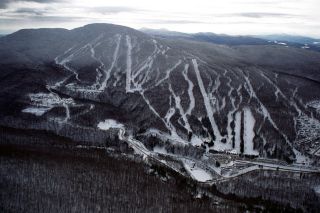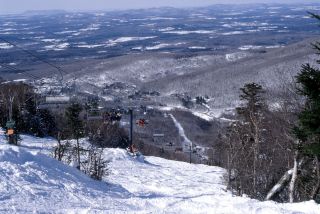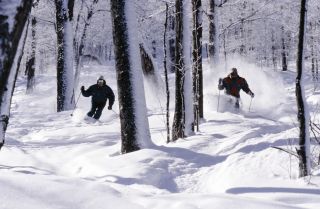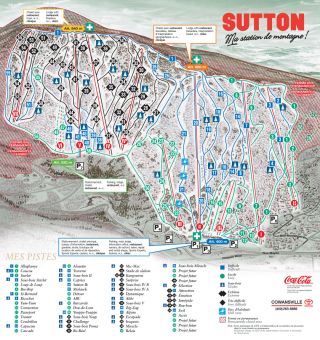Sutton (QC), Canada – The region of Québec that borders Vermont is known by two names: The Eastern Townships in English, or l’Estrie in French. The area is a patchwork land of French and English, the latter towns first settled by British loyalists escaping the American Revolution more than 200 years ago. To this day, these pockets of the English language remain, and many of the names reflect their British heritage: Knowlton, Bolton, Waterloo, and Sutton, amongst others. The latter is also home to one of the region’s largest ski resorts, the eponymous Mont Sutton.

Mont Sutton (photo: Mont Sutton)
Mont Sutton’s glades are more open than the eastern norm. (photo: Mont |
Reflecting this duality, Mont Sutton also has two personalities: the old school, and the new. It’s a mountain slowly being reborn out of decades of ski heritage. Thankfully, the development is being accomplished with the heritage in mind.
THE OLD AMONGST THE NEW
A couple of years ago, the “Sutton – Ma station de montagne!” (“Sutton – My Ski Mountain!”) advertising campaign was born, featuring a rad dude skier model smiling broadly for the camera from behind long, blonde locks and mirrored goggles. It’s a stark contrast with a ski area sporting center-pole double chairlifts, homey chalets, and traditional native maple taffy served in spring liftlines. Sutton is finding a new identity, but skiers and snowboarders visiting this Townships resort will still find old-school hospitality and entertaining terrain. It may be only a few scant miles across the border, but for American visitors the language, the culture, and the cuisine make it feel like a world away.
Mont Sutton is spread along a broad ridgeline. Although the overall vertical drop of 1,500 feet borders on the big leagues, a skier will be hard-pressed to find a single run of more than 1,000 verts. While the ridgeline gradually decreases in height from one end to the other, the base elevations do likewise, thus limiting the vertical drop skiable in a single run. Never mind those modest statistics, however, for they belie a mountain of character and challenge, a mountain of variety and interest. You’ll never wish for more vertical at Sutton.
Sutton is uniquely blessed by a topography that steepens as you head from east to west, from climber’s right to climber’s left. If you’re looking to amp things up a notch, simply move over a lift. In over your head? Just move over to a lift in the other direction. You’ve got no fewer than nine chairlifts from which to choose.
Mont Sutton was a pioneer in gladed skiing literally decades before regional neighbors caught on to the craze. For half of the mountain, the tree areas between the marked trails are cleared, providing an open free-for-all for those willing to explore. In fact, a full 40% of Sutton’s terrain is gladed. While these glades may be somewhat more open than today’s norm – some of the spaces are big enough to drive a snowcat through – an imaginative skier can link a nearly limitless combination of lines from the top of any lift to the bottom. The statistic of “53 trails and glades, 194 trail junctions” says it all – the options are dazzling. The terrain falls away in a series of stair steps, eliciting many a whoop and a holler from this author over the years.
RETURN TO “MA STATION DE MONTAGNE”
Our car whined as it climbed the steep access road from the village of Sutton to the ski resort late on a cold February night. 20 cm (eight inches) of snow was forecast overnight, and dreams of powder turns danced in our heads as we fell asleep in a cozy slopeside condominium, but only after settling in by the fireplace and swapping stories of fresh turns, of pleasant glades, and of the mountain known as Sutton.
Alas, we awoke in the morning to only a trace on the surface. No matter, though, for this was Sutton, a mountain that was sure to entertain. A skier’s delight, Sutton as never failed to deliver, and surely it wouldn’t fail to this time, either. We stepped out of the condo, clicked into our skis, and traversed down and over to the main base lodge.
Sutton’s base lodge, known by it’s altitude as the “Alt. 400m Chalet” is, to be honest, a cramped quarter on a Saturday. Dating to the ski resort’s founding in the 1950s, the building itself evokes an era gone by. Red clapboard siding protects a cozy space within, where fresh breakfast specialties were being prepared for hungry skiers. An effort to improve upon the tight space contained therein was made last season, when the Sports Experts retailer was relocated to a separate building, freeing up space for resting skiers and riders in the existing base structure.
A symbol of the “new” Sutton, Chair II, a high-speed detachable quad, ascends from the Chalet 400m to Alt. 680m, one of the mountain’s two summit lodges. The skiing here in the center of the resort is a diverse mix of intermediate offerings, from rollicking cruisers to gentle, widely-spaced glades. “Intermediate” at Sutton does not equate with “boring,” for these trails dip and wind their way to the base. Even experts could be entertained with a day spent solely on these trails.
With 496 cm (195 inches) annually, Sutton is one of the snowfall leaders in the province of Québec, and lies a mere spitting distance from Jay Peak on the Vermont side of the border. Frequent replenishing snowf alls freshen the conditions on Sutton’s trails and in their glades, a delight for visitors week after week.
When we were ready for more challenge, however, we headed to skier’s right to ride chairs IV, IVo, V and VII, for it’s here that Sutton offers its most engaging terrain for expert skiers and riders, from groomed cruising along La Dynamique to the steep bumps of Kangourou. Intrepid experts should keep an eye out for the entrance to La Fantasie, a marked trail that nonetheless fails to appear on the trail map, dropping to the left of the Alleghanys trail into an area that, frankly, is marked as “permanently closed” on the trail map. La Fantasie will carry you across a series of steep, treed ledges beyond the obvious ski area boundary. Make sure to catch the traverse back to the base of Chair Io, however, for although the turns beyond it look inviting, it’s a long walk back to the ski area for those greedy enough to seek more.
At this end of the resort, Chairs I and Io provide nearly all of Sutton’s green-circle cruising for novices. Even these trails, however, are not without interest, and we happily spent more than one lift ride sampling their twists, curves and even a couple of steep shots in the woods between the trails. This is eastern skiing at its finest, skiing that hasn’t lost sight of its heritage. And Sutton has heritage in spades.
A FAMILY HISTORY
Sutton was borne of the dreams of Harold Boulanger, a local farmer whose land holdings included the ridgeline upon which the ski area was built, and his son Réal and a family lawyer, friend and advisor, François Lévesque. Harold was looking for a way to keep his farm’s employees working throughout the harsh Québecois winter months, and Réal’s vision to open a ski area on the family property was just the ticket.
Skiing had existed in Sutton since the 1930s, on the north side of Lac Mohawk (a neighboring mountain), and the Boulanger family became involved in the sport in the 1940s. It wasn’t until the 1955-56 season, however, that the Boulangers rode their first mechanized lifts at a ski area in nearby Vermont, and began to dream.
Harold arranged the financing, and the children took care of the rest, and work began on the mountain and chalet in 1960. The resort fired up its first lifts in December of 1960 after four inches of fresh snow fell the night before.
Today, four generations later, Mont Sutton remains in the hands of the Boulanger family. Like most Québec ski areas, they’ve had their financial ups and downs, but Mont Sutton is presently a thriving business that is currently enjoying dramatic increases in its skier visits. Barely over an hour from the metropolitan Montréal region, Mont Sutton has a significant skier base from which to draw, and the relative bargain provided by a favorable exchange rate with the U.S. Dollar, although less so in recent months, continues to draw an increasing number of American visitors.
A CHARMING VILLAGE

Sutton’s steepest terrain is at the eastern end of the resort. (photo: |
The village of Sutton would exist with or without the ski resort, but the ski area’s presence has enhanced the region’s offerings nonetheless. The tiny “downtown core” offers an eclectic assortment of shops, restaurants, inns and boutiques, as does the access road from the village to the resort.
We started off the evening après-ski at La Paimpolaise, a hotel near the base of Chair Io with a cozy and lively downstairs bar. It was here that we befriended a half dozen Sutton regulars, and our newfound friends chose to join us for dinner at a local staple, Il Dueto.
Il Dueto offers a dining experience in Sutton that shouldn’t be missed. Several miles up an unpaved road outside of town (227 ch. Academy-Élie, 450-538-8239), the restaurant exists inside a converted farmhouse, offering fine Italian cuisine. The menu boasts such delicacies as veal-stuffed cannelloni with olive oil and Pecorino cheese; red linguine with black olives, olive oil and garlic sauce; and boneless quail and duck breast in balsamic bittersweet sauce, all in an intimate candlelit setting. Many glasses of wine were emptied over fine cuisine and warm conversation as we enjoyed a special evening in Sutton with our friendly companions.
In the center of town, L’International Resto-Bistro (10d Principale Sud, 450-538-1717) is a unique hybrid of a takeout café and gourmet dining room where Osso Bucco a la Milanaise, Lapin a La St-Ambroise (rabbit) and Foie de Veau Sauce aux Pêches (calves liver in a peach sauce) highlight the menu. Save room for dessert, for L’International’s pastries are second to none. It’s also a terrific place for a morning pick-me-up of espresso and croissants before a full day on the slopes. American diners, accustomed to our own diet of processed foods, will have a tough time going wrong eating anywhere in Québec, a land where fresh preparation still rules, but these two establishments lay claim to some of the best cuisine that the Sutton region has to offer.
Full from a superb meal, our own stomachs’ groaning joined the groaning of the car’s engine as we returned to our condo. The morning would bring another day at Sutton, now Ma Station de Montagne!


